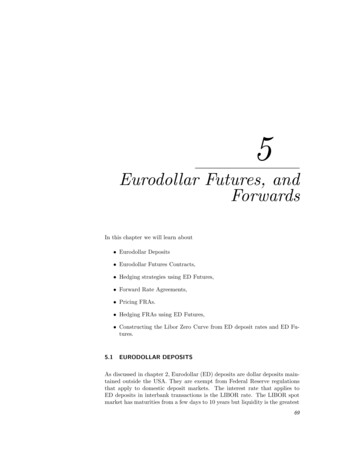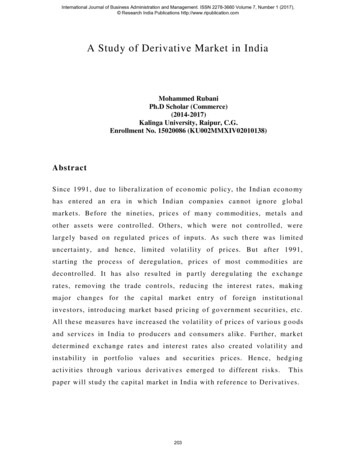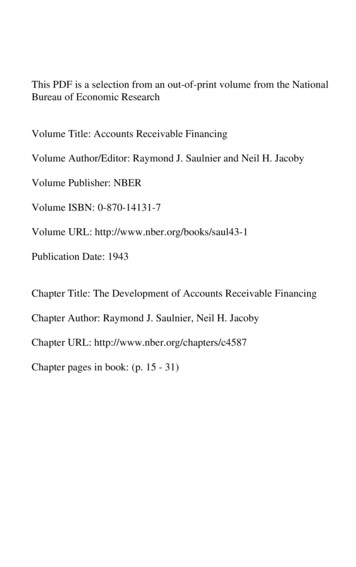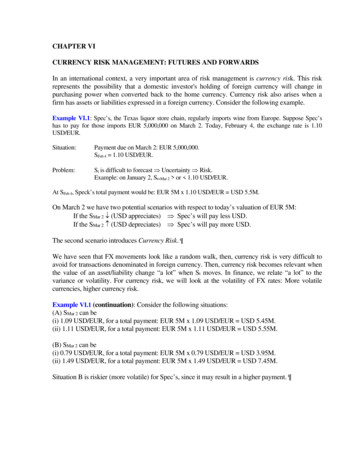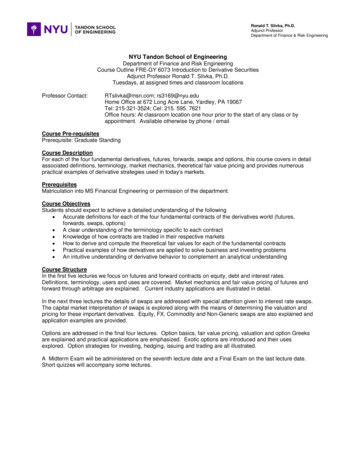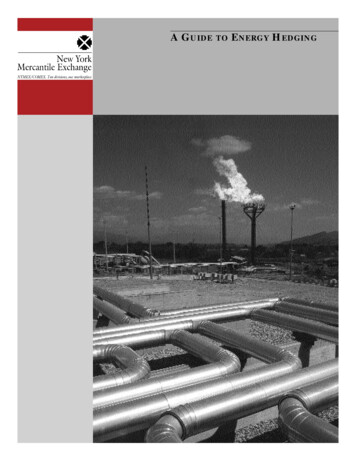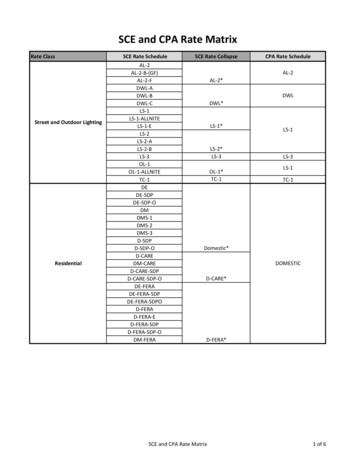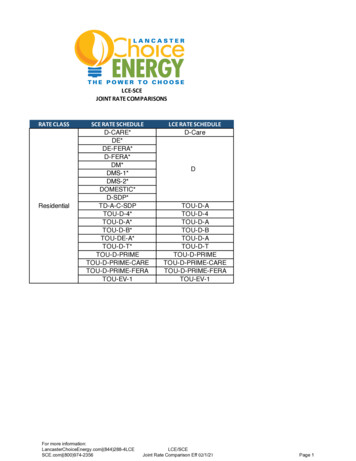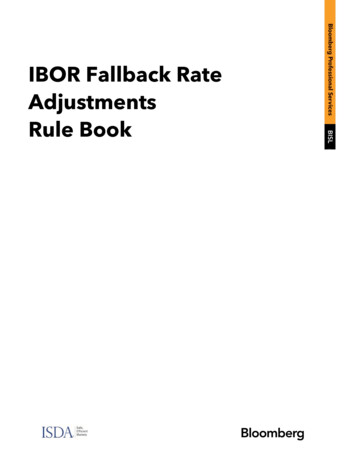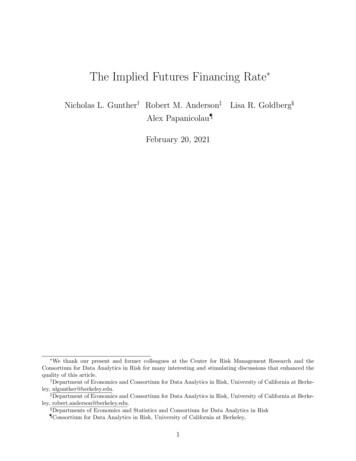
Transcription
The Implied Futures Financing Rate Nicholas L. Gunther† Robert M. Anderson‡ Lisa R. Goldberg§Alex Papanicolau¶February 20, 2021 We thank our present and former colleagues at the Center for Risk Management Research and theConsortium for Data Analytics in Risk for many interesting and stimulating discussions that enhanced thequality of this article.†Department of Economics and Consortium for Data Analytics in Risk, University of California at Berkeley, nlgunther@berkeley.edu.‡Department of Economics and Consortium for Data Analytics in Risk, University of California at Berkeley, robert.anderson@berkeley.edu.§Departments of Economics and Statistics and Consortium for Data Analytics in Risk¶Consortium for Data Analytics in Risk, University of California at Berkeley,1
Contents1 Introduction.32 Literature43 Interest Rates Implied by Futures3.1 General Case without Dividends . . . . . . . . . . . . . . . . . . . . . . . . .3.2 The Expected Discount and the IFFR . . . . . . . . . . . . . . . . . . . . .3.3 General Case with Dividends . . . . . . . . . . . . . . . . . . . . . . . . . . .559114 The4.14.24.313141416Model of Stock and Interest RatesSpecification . . . . . . . . . . . . . . . . . . . . . . . . . . . . . . . . . . . .Preliminary Results for Later Use . . . . . . . . . . . . . . . . . . . . . . . .Canonical Coordinates for Brownian Diagonalization . . . . . . . . . . . . .5 Estimating the Model5.1 Objective and Methodology for Model Estimation5.2 Estimating (σ r )2 . . . . . . . . . . . . . . . . . .5.3 Is the Estimate σb2 d Reasonable? . . . . . . . . .5.4 Estimating σ S , ρ . . . . . . . . . . . . . . . . . . .5.5 Estimating the Convexity Adjustment . . . . . .1818202526306 Spread Analysis317 Summary341
The Implied Futures Financing RateAbstractWe explore the cost of implicit leverage associated with an S&P 500 Index futures contractand derive an implied financing rate (the Futures-Implied Rate or FIR), based on a simplemodel of stock and futures, without any explicit arbitrage or other relationship to marketinterest rates. We develop new estimation methods for the FIR, including point and intervalestimates, with important advantages over existing methods, and extend our methods tobivariate estimates of the FIR and equity volatility based on Wishart distributions. While ourresulting FIR estimates were often attractive relative to market rates on explicit financings,the relationship between the implicit and explicit financing rates was volatile and variedconsiderably based on legal and economic regimes. Among our significant findings was theeffectiveness of regulatory reform in reducing substantially the spreads between this FIR andcontemporaneous LIBOR and US Treasury rates. Other findings include estimates of theconvexity adjustment associated with the FIR, futures-based estimates of stock volatilityand stock-rate correlation, and new test statistics for the significance of these estimates.2
1Introduction.What is the true financing cost of a levered equity investment strategy? Generally speaking,an investor who wishes more exposure than her free cash permits has two choices: she canborrow and add the debt proceeds to her cash investment, or, as discussed in this article,she can obtain implicit leverage through the derivatives market.1 In this paper, we explorethe cost of implicit leverage associated with a prominent equity index futures contract. Insummary, our research shows that the related implicit financing rate has often been attractiverelative to market rates on explicit financing; however, the relationship between the implicitand explicit financing rates has been volatile and varied considerably based on legal andeconomic regimes.The purchase of an S&P 500 Index2 futures contract3 results in exposure to a notionalamount of the underlying in exchange for a current payment much less than that notionalamount.4 Intuitively, this suggests financing; a levered purchase of the underlying equitiesprovides similar exposure and cash flows. In this paper, we consider a stock and two futurescontracts on the stock, from which we derive an implied forward financing rate (the futuresimplied rate, or FIR). This rate represents the implicit cost of financing associated withsuch an investment in a futures contract. The spread between this implied rate and marketinterest rates evolved dynamically over a series of four regimes that we identified duringour total observation period from January 1996 to June 2019. The Commodity FuturesModernization Act of 2000 (“CFMA”) reduced this spread; the 2008 financial crisis and thesubsequent recovery each altered it further.1For an exploration of explicit leverage, see, e.g., Anderson et al. (2014).The term ‘S&P 500 Index’ is a registered copyright of Standard & Poors, Inc.3Unless otherwise stated, the terms futures contract in this article refers to such an S&P 500 Index futurescontract. The terms of such futures contracts are specified by the Chicago Mercantile Exchange (CME ) forthe big (or floor ) and the small (or E-mini ) futures contracts traded through the CME. Current terms forsuch futures contracts are available on the CME’s website. The CME has other futures contracts relatedto the S&P 500 Index, including contracts that reflect dividends on the index components. These othercontracts lack the volume and the history of the traditional contract we choose.4The payment required to execute a futures contract consists principally of initial and variational margin;leverage of 10:1 or higher is often possible. See footnote 3.23
We begin our investigation of the FIR with few restrictions on the stock and futures priceprocesses, and then for more explicit results specialize to a simple model of stock and futures,without any explicit arbitrage or other relationship to market interest rates.2LiteratureThe futures literature is extensive5 and the relationship between futures prices and interestrates is well-studied in the customary context of no-arbitrage pricing.6 There is however,little on that relationship outside that no-arbitrage context, where market rates and ratesimplied by futures can be unequal.7 Recently, recognition that simple static models offutures hedges are inadequate has appeared.8 Our current article investigates the interestrate implied by S&P 500 futures prices determined independently from market interest rates,to our knowledge for the first time.9Anderson et al. (2014) analyze the cost of explicit financing in a levered equity investmentstrategy; the current article provides a companion analysis of the cost of implicit financing.5Dating back at least to, e.g., Black (1976).See, e.g., Cox et al. (1981) (showing, inter alia, that futures and forward prices are equal if rates aredeterministic.)7For example, because, unlike forward contracts, as a result of variational margin (see footnote 4), hedgesbetween positions in the underlying physical stock and in futures contracts are dynamic and thus leaveresidual open risk.8Contrast Dwyer et al. (1996) (using a simple static cost of carry model to explore the nonlinear relationship between the S&P 500 Futures and the underlying stock) with Hilliard et al. (2021) (using a ’short-livedarbitrage’ model proposed in (Otto, 2000) to compute minimum variance hedge ratios.)9The futures literature discusses many other topics not relevant to the current investigation. See,e.g., Chen et al. (2016) (comparing price discovery in futures, index options and ETFs) and referencescited therein; Chan et al. (1991) (comparing volatility in the cash and index futures markets); Bali et al.(2008)(testing mean reversion in S&P 500 futures) and Lien (2004)(investigating the effect of cointegrationon hedging effectiveness.)64
3Interest Rates Implied by Futures3.1General Case without DividendsThe basic equations for futures and implied financing rates used in this paper come from thewell-known no-arbitrage relationship that relates the futures price F (t, T ) at the current timet to the expected stock price S(T ) at the maturity date T of the relevant futures contract,conditioned on the information at time t:Theorem 3.1. Futures as ExpectationF (t, T ) Et [S(T )] EQ [S(T ) t] EQ [S(T ) Ft ](1)This result is true quite generally, independent of any particular model for the stock orinterest rates. The Computational Appendix contains a proof in continuous time.10In Equation (1), EQ [S(T ) Ft ] denotes the expectation of S(T) conditional on the information available at an earlier time t under the risk neutral measure Q associated with risklessinvestment in a money market account we denote by M (t0 , t1 ), t0 t1 . We will assume thereis a short rate process r(t) associated with this riskless investment. The related (stochastic)discount factor (or just discount) is also denoted by M but with time order reversed:R t1M (t0 , t1 ) et0r(s)ds, M (t1 , t0 ) 1M (t0 , t1 )We assume that rt is attainable11 from the stock, the near futures contract and the nextfutures contract on the S&P 500 Index.12 Such a short rate process need not be equivalent to10For a proof in the discrete case, see, e.g., (Anderson and Kercheval, 2010, Chapter 4).A claim is attainable from other claims if there is a self-financing trading strategy in those other claimsthat has the same payoffs as the first claim. See, e.g. (Anderson and Kercheval, 2010, Chapter 2.3).12These contracts are traded on the Chicago Mercantile Exchange. In market terminology, the nearcontract is the one with the earliest possible maturity after the observation time, and the next contract isthe one with next earliest maturity. The difference in the maturity dates of two consecutive S&P 500 Indexfutures contracts, such as the near and the next, is typically approximately three months. In this research,115
a market interest rate, where two rates are equivalent if they may be swapped into each otherat no cost.13 Instead, it is the rate of riskless investment attainable through a self-financingportfolio in the stock and the futures, and as such represents the FIR.We assume there is no arbitrage and, at first, also that S pays no dividends. Accordingly S(t) equals its expected discounted future value under the standard Martingale PricingFormula (MPF ):14S(t) Et [S(T )M (T, t)], T t(2)Using this and the well-known relationship between the covariance and the expectation ofa product of two random variables, the inverse futures ratio (IFR) is given by:Et [S(T )M (T, t)]S(t) F (t, T )F (t, T )Et [S(T )]Et [M (T, t)] covt (S(T ), M (T, t)) F (t, T )F (t, T )covt (S(T ), M (T, t)) Et [M (T, t)] E [S(T )] tS(T ) Et [M (T, t)] covt, M (T, t)Et [S(T )] S(TM (T, t) Et [M (T, t)] 1 covt,Et [S(T )] Et [M (T, t)]IFR (3)(4)(5)(6)Equation (4) follows from Equation (3) by Equation (1). Equation (5) follows from Equationwe have used the big or floor contract because of its longer existence; in later years the volume of the E-miniis typically larger but the closing prices are almost always the same.13Two equivalent rates are said in the market to have a zero basis between them. ‘Equivalence’ in thissense requires a static hedge, so that each rate is attainable from the other in a very simple way using marketinstruments. Compare Footnote 11 above. In the absence of arbitrage, two equivalent rates should differ bytheir credit risk, and as a result of variational margin and other credit mitigation features the risk associatedwith futures is extremely low. Were the FIR and a market rate equivalent, one would expect the FIR totrack closely the risk-free rate. Figure (1) does not support such equivalence.14The MPF states that the current price of a security or other self-financing trading strategy equals theconditional expectation of its discounted future cash flows, including its terminal future value, discountingby the riskless investment or other numeraire. (Anderson and Kercheval, 2010, Chapter 3). In the absenceof dividends, the terminal future value is the only future cash flow, as in the equation in the text.6
(4) since Et [S(T )] is known at time t. Finally, Equation (6) follows because Et [M (T, t)] isalso known at time t.The IFR is the ratio of the current stock price to the futures price and thus measuresthe discount implied by the futures. Equation (5) says simply that this measure equals theexpected discount plus a covariance term. The first term on the right in Equation (5) is theexpected term discount factor over [t, T ], corresponding to the FIR. The final term on theright in Equation (5) equals the covariance of the stock price and the FIR discount factor attime T around their expected values, viewed from time t.It is instructive to compare Equation (5) with the analogous equation for a fair forwardcontract with forward price Fo (t, T ). Since the price of a fair forward contract should bezero, we have from the MPF:S(t) Fo (t, T )Et [M (T, t)]or equivalently,S(t) Et [M (T, t)]Fo (t, T )(7)Comparing Equations (5), (6) and (7) and recalling the definition of the IFR, we see thatthe covariance term may be thought of as a convexity adjustment.15For empirical reasons,16 it is easier to work with two futures contracts, the near and the15Lacking a covariance term, the determination of an implied financing rate from a forward appearssuperficially more appealing than the more complex determination from a futures contract. More basically,an equity forward on a stock has two cash flows: a current fixed cash payment and a future equity-linkedpayment on the notional amount at maturity. Because there are only two cash flows, the forward-impliedfinancing rate can be directly observed. By contrast, a futures contract has daily, often substantial cashflows in respect of variational margin, in effect marking the contract to market daily. Therefore determiningthe associated implied financing rate requires financial theory, as Equation (5) demonstrates. However, forcredit and other reasons, forwards are OTC, not exchange traded, illiquid and bespoke, and so the contractterms, from which financing rates could be directly observed, are private and not fungible.16These reasons include high price volatility, asynchronicity between the close of the cash and the futuresmarkets, market segmentation and the substantial volume of daily transactions in both the spot and the7
next,17 and the inverse forward futures ratio than the inverse futures ratio itself. We willalso need the forward discount M (T2 , T1 ). We define the inverse forward futures ratio orIFFR by:IF F R F (t, T2 , T1 ) F (t, T1 ),F (t, T2 )where T2 T1 are the maturities of the next and the near futures, respectively, and the finalquotient is the near contract futures price divided by the next contract futures price, in eachcase observed at time t.In this article, generally consistent with our data, we assume that T T2 T1 0.25(A1)T2 0.5(A2)We measure time in years, so T 0.25 of one year, or one-quarter.18 By Assumption (A1),Assumption (A2) is equivalent to assuming T1 0.25.futures markets. See generally Anderson et al. (2013). A more detailed description of our methodologyappears in the Computational Appendix.17See Footnote 12 above.18Id. These assumptions come from the approximately quarterly calendar of futures contracts.8
3.2The Expected Discount and the IFFRWe can now begin the derivation of our basic equation. We start with the IFFR definition:F (t, T1 )Et [S(T1 )] F (t, T2 )F (t, T2 )Et [S(T2 )M (T2 , T1 )]Et [ET1 [S(T2 )M (T2 , T1 )]] F (t, T2 )F (t, T2 )Et [S(T2 )]Et [M (T2 , T1 )] covt (S(T2 ), M (T2 , T1 )) F (t, T2 )F (t, T2 ) S(T2 ) Et [M (T2 , T1 )] covt, M (T2 , T1 )Et [S(T2 )] M (T2 , T1 )S(T2 ), Et [M (T2 , T1 )] 1 covtEt [S(T2 )] Et [M (T2 , T1 )]IF F R (8)(9)(10)(11)(12)where Equation (9) follows from the Tower Law and Equations (11) and (12) follow fromEquation (10) since F (t, T2 ) Et [S(T2 )] which is known at time t, as is Et [M (T2 , T1 )].By analogy to Equations (5) and (7), we see that the covariance term in Equation (12) issubstantially the same as a forward forward-futures adjustment.19Thus the inverse forward futures ratio F (t, T2 , T1 ) is the expected forward discount factorEt [M (T2 , T1 )] multiplied by a convexity adjustment based on a covariance term CXt 1 CTt 1 covtST2M (T2 , T1 ),Et [ST2 ] Et [M (T2 , T1 )] Et [ST2 M (T2 , T1 )]Et [ST2 ]Et [M (T2 , T1 )](13)The last quotient will prove useful in computing the SDE for CXt in our model.Condensing, we have our basic equation:IF F R Et [M (T2 , T1 )] CXt Et [M (T2 , T1 )] IF F RCXt(14)Equation (14) expresses the unobservable expected forward FIR term discount as theobservable IFFR scaled by CXt . Because they are conditioned on Ft , both CTt and CXt19Compare Equations (5), (7) and Footnote 15 and accompanying text.9
are deterministic functions of t determined by the unknown parameters of the processesM and S.While S and IFRR are both observable,20 M is not, and therefore CXt is also unobservable.Equation (14) thus expresses the unobservable (expected) FIR on the left-hand side in termsof the unobservable CXt on the right-hand side, which also depends on the unobservableM (T2 , T1 ). The unobservable M (T2 , T1 ) therefore appears on both sides of Equation (14),creating an apparent circularity in the estimation expression we wish to use - to use Equation(14) to estimate the FIR that appears by itself on the left-hand side, we must already knowit to determine the denominator ( CXt ) on Equation (14)’s right-hand side.Were these quantities simply unknown numbers, standard algebra might provide a solution, but instead they are time-dependent and determined from an unobservable stochasticquantity (M (T2 , T1 )) with unknown parameters. In Section 5.5 below, we develop a newcalculus to resolve this circularity and provide an explicit estimate of CXt based on ourmodel.CXt ’s Effect Should be Insignificant We sketch a rough argument that on our data,the effect of CXt is likely to be small and thus Et [M (T2 , T1 )] should equal the IFFR withmodest error. We then preview our later result that this error is in fact insignificant outsidea small minority of periods, making the FIR directly observable as a practical matter, withnegligible error. See Figures (7) and (8).20But only imperfectly. The S&P 500 is the hypothetical portfolio of stocks underlying an index, observingwhich raises asynchronicity and other issues. For example, the index at each instant in time is a weightedaverage of the most recent trade prices of the constituent stocks. Since the S&P 500 stocks are relativelylarge and liquid, on most days there will be at least one trade of most or all of the stocks, but there maybe days on which some stocks do not trade at all, in which case the price information would be stale byat least 24 hours. The more common situation in these relatively large stocks is that the last trade occursseveral minutes or even several hours before the close; for example, there are occasional trading halts inspecific stocks. For different stocks, the time of the last trade may therefore differ. For another example,trading does not actually stop at the nominal close (4 pm). At the close, there will be some limit orders andbuy/sell on close orders that remain to be executed. These orders are crossed, with trading times up to tenminutes after the close. To that extent the closing price of each of the individual constituent stocks may notbe known at the close. See, e.g., Anderson et al. (2013)10
S&P 500 volatility typically averages less than 20%, interest rate volatility is approximately1% and correlation never exceeds 1 in absolute value. CTt measures covariance over at mostsix months for stock volatility and three months (one quarter) for rate volatility; over suchshort periods drift may generally be ignored and variation is almost entirely from volatility,which scales with the square root of time. Therefore on average and approximately CTt 20% 0.7 1% 0.5 7 basis points.(15)Because this is a multiplicative factor, CXt would be less than eight additive basis pointseven were the FIR as high 10%.This approximation relies on several assumptions, including that FIR volatility is similarto market interest rate volatility. Because the FIR is unobservable, this not obvious. Thefollowing sections develop a novel method for estimating FIR volatility based on a bivariatemodel of stock and the FIR, and use it to show the convexity adjustment materially exceeds a basis point in only a small number of periods, based on related estimates from thefutures of the S&P 500’s volatility and correlation with the FIR. Details are deferred to theComputational Appendix.The practical conclusion is that the FIR can generally be determined with negligible errorfrom the quotient of two observable futures prices, after adjustment for dividends as described in the following subsection. Investigating those few periods in which the convexityadjustment is significant, although potentially interesting, is outside the scope of this article.3.3General Case with DividendsThe previous equations assumed that the stock S(t) pays no dividends. However, manystocks in the S&P 500 Index pay dividends that have been significant in many periods. Wemust therefore modify Equation (14) to reflect dividends.11
We obtained implied dividend rates rdiv (t) on the S&P 500 from the option markets, basedon put-call parity.21 As derived in the Computational Appendix,22 the required modificationto Equation (14) is:Et [M (T2 , T1 )] kdiv (t) IF F R.CXt(16)where23kdiv (t) 1 rdiv (t) T.The value kdiv (t) lies between 0 and 1.24 Thus in the presence of dividends the left-handside of Equation (14) decreases by kdiv (t). As a result of this formula, we can include theeffect of dividends by applying to the IFFR a discount of kdiv (t) (or equivalently increasingthe forward futures ratio by1)kdiv (t)and then computing as though there were no dividends.Equation (16) can be written in identical form to Equation (14) if we replace IFFR withkdiv (t) IF F R; except where explicitly otherwise indicated, we will do so hereafter tosimplify notation.Figure (1) shows the FIR determined from the IFFR as described at the end of Section 3.2,adjusted for dividends but not convexity, expressed as a rate and appropriately annualized.This graph, with US Treasury and LIBOR rates included for comparison, provides informal,visual confirmation that the FIR behaves similarly to market interest rates, although it isnot equivalent to any of them. A more precise statement requires the model in the followingsection.21Wharton Research Data Services’ OptionMetrics contains a time series of estimated implied dividendrates rdiv (t) obtained from a regression with the property that the present value at time t of the implieddividends over (t, T ] equals rdiv (t) S(t) (T t), where S(t) is the price of the associated stock at time t.See Ivy DB File and Data Reference Manual 30, Version 3.0, revised May 19, 2011.22Computational Appendix [? ?].23Time is measured in full years, so a six-month interval measures 0.5.24Since (1) T is on the order of a quarter and (2) dividend rates on the S&P 500 have always beenpositive but less than 400% (an extremely high rate).12
4The Model of Stock and Interest RatesFrom Equation (16), the FIR cannot be observed, but must be estimated. The necessaryquantity to estimate is CXt , because the IFFR is observable. We will propose a simplebivariate model for rates and the stock underlying the futures contracts that will allow this Et [ST2 M (T2 ,T1 )]estimation. To preview, we will find the following form for CXt Et [ST ]Et [M (T2 ,T1 )] :2CXt ea(t)(σr )2 b(t)σ r σ S ρ IFFR Et [M (T2 , T1 )] ea(t)(σr )2 b(t)σ r σ S ρ(17)where a(t), b(t) depend on the underlying (unobserved) vector of parameters θ (σ r , σ S , ρ)of our model but are otherwise deterministic. We will estimate θ along with confidenceregions, and will then use these confidence regions for the vector θ to derive 95% confidenceintervals for the unknown scalar CXt . Observing that the convexity adjustments CXt arenegligible in the large majority of these confidence intervals, we will conclude that with95% confidence, the convexity adjustments CXt are negligible in the corresponding largemajority of our observation periods, from which we will finally deduce that the FIR discountEt [M (T2 , T1 )] may generally be taken to equal the observable IFFR with negligible error,and the FIR estimated accordingly.[cS , ρb. The balancer )2 , σdt follows from estimates for (σFrom Equation (17), the estimate CX[cS , ρb willr )2 ; estimation of σof this section will described our model and the estimation of (σbe summarized and the details deferred to the Computational Appendix.13
4.1SpecificationWe rely on a Ho-Lee interest rate model and a standard stock lognormal model. In matrixform, it is rrr drt µ dt σ dBt dStSSrt dt σ dBtSt(18) with dBt dBtS , dBtr a two-dimensional Brownian motion with instantaneous correlationρ and rt FIR(t). The parameters µr , σ r , σ S , ρ are all constant.4.2Preliminary Results for Later UseRestricting to our model, we have the following useful technical propositions. The proofsare deferred to the Computational Appendix.Let F(t,T) denote the futures price at time t under a futures contract on the stock St withexpiration at time T.Proposition: 4.1. Stock Price EvolutionRTS(T ) St et RS2ds tT σ S BsSrs σ 2(19)The next proposition, which follows from the first and Theorem (3.1), describes the futuresprice evolution in our model.Proposition: 4.2. Futures SDE:dF (t, T ) (T t)σ r dBtr σ S dBtSF (t, T )The third proposition describes the FIR discount evolution in our model.14(20)
Proposition: 4.3. FIR Discount EvolutiondEt [M (T2 , T1 )] (t T1 T2 )σ r dBtr , T2 T1 , tEt [M (T2 , T1 )])(21)From Proposition 4.3, consistent with one’s intuition, Et [M (T2 , T1 )] continues to evolvefor T1 t T2 , but with diminishing volatility.The final proposition provides the explicit formula for CXt discussed at the beginning ofthis section.Proposition: 4.4. Convexity EvolutionEt [M (T2 , T1 )ST2 ] Et [M (T2 , T1 )] Et [ST2 ]eU1 (T2 ,θ) U2 (t,θ)where U1 (T2 , θ) U2 (t, θ) (σ r )2 1 11σr S2 (T2 t) σ ρ T1 t 4 2 4848 a(t) (σ r )2 b(t)σ r σ S ρProposition 4.4 follows from Propositions (4.1) and (4.3). Details are deferred to theComputational Appendix.It will be helpful to express Proposition 4.4 as a quadratic form: r σ ρσ Q(t) ρσ S 11112T1 t 8 8 48 (T2 t)8Q(t) 11T t 0188 U1 (T2 , θ) U2 (t, θ) σ r15 S(22)
The form Q is deterministic and can be computed once, independent of the particular(next, near) pair of futures for which the convexity term is estimated.4.3Canonical Coordinates for Brownian DiagonalizationLet Fi , i 1, 2 be two futures (a futures pair ) on the stock St with sequential maturities(expiration dates) T1 T2 . From Proposition 4.2:dFi (Ti t)σ r dB r σ S dB s , i 1, 2FiWe wish to diagonalize these two SDEs in terms of the bivariate Brownian motion dBt .Using a change of variables to isolate the Brownian motion in terms of stochasticallyintegrable quantitieslog F2 log F1,T2 T1T1 tT2 tlog F1 log F2Y T2 T1T2 T1X Note that X 1T2 T1 log F2F1and so functions as a proxy for the IFFR. X, Y are bothobservable and have the following SDEs: rrσ dB dg(t; θ) dX dYσ S dB s dh(t; θ) Xdtwhere θ (σ r , σ S , ρ), dB r dB s ρ andZ t (T2 s)2 (T1 s)2 r 2r S(σ ) 2σ σ ρ ds,T2 T10Z1 t h(t; θ) (T2 s)(T1 s) (σ r )2 ds (σ S )2 ds2 01g(t; θ) 2g, h are deterministic but depend on θ.16(23)
Integrating Equation (23), rearranging and using the approximation25Z1Xdt (Xt t Xt ) t XAvg t2we may discretize Equation (23): 2σ r Btr (σ r ) (T1 t) t X c1SSr 2σ Bt XAvg t 2 (σ ) t (t T1 )(t T2 )) Y(24)where c is a (vector) constant depending on θ.26We rewrite Equation (24) in terms of the Brownian motion increments: r 2 rr X (σ ) (T1 t) t σ Bt c 1SSr 2 Y XAvg t 2 (σ ) t (t T1 )(t T2 ))σ Bt(25)Equation (25) illustrates, in the context of our model, the circularity referred to in Section3.2 above. If we knew the unknown parameter (σ r )2 we could determine the right-handside, up to the unknown constant, detrending the observations of X and Y and leavinga series of fully-observed iid samples of the bivariate Brownian increments on the left-handside. We could then estimate the covariance matrix of the left-hand side with the usualmethods. However, the parameter (σ r )2 we need to estimate the covariance matrix in thismanner is itself one of the entries the covariance matrix we wish to estimate. The nextsection describes the modification required to the usual methods to resolve this circularity.25Since we observe both Xt t , Xt , X is based on a Brownian Bridge. [The Computational Appendix provides further justification for this approximation.]26Herein ‘c’ denotes a constant, generally differing based on the context.17
5Estimating the Model5.1Objective and Methodology for Model EstimationObjective. Our basic equation for the FIR is Equation (17). In that equation, the IFFR isobserved directly, but from Proposition 4.4 and Equation (22) the convexity adjustment thatmultiplies the IFFR to determine the FIR discount depends on the two unknown quantities,a variance and a covariance (σ r )2 , σ r σ S ρ, with the observed deterministic coefficients givenin Proposition 4.4.Equation (1) relies on the absence of arbitrage, as does our model at certain other points,so the relevant variance and covariance derive from the risk-neutral measure. Instead, weestimate these quantities in the
model of stock and futures, without any explicit arbitrage or other relationship to market interest rates. We develop new estimation methods for the FIR, including point and interval estimates, with important advantages over existing methods, and extend our methods to bivariate estimates of the FIR and equity volatility based on Wishart .
